Overview
Sunflowers (Helianthus annus) belong to the Asteraceae plant family. The flowers of this plant are remarkably large and tall, standing on upright, hairy, leafy stems. Sunflowers are available in sizes ranging from dwarf 12- to 24-inch plants to gigantic 10-foot plants.
Blooming during the summer months and attracting birds and bumblebees, sunflowers are annuals, fast-growing and robust, especially when provided ideal growing conditions. Although most sunflowers are grown as annuals, some perennial types too exist.
Numerous varieties of sunflowers exist, and the visual characteristics will differ from one variety to the next. Colors of sunflowers range from creamy white to shades of red, orange, gold and yellow and can include hints of brown and green as well. There are even some varieties that have striped flowers. Approximately, the blooms are typically between 2 to 4 inches across.
Some sunflower varieties display a double bloom that results in a flower head that is fluffier. These varieties of double-blooming sunflowers have a center that matches the yellow outer ring of flowers. Other varieties display Single-blooms. Single-bloom sunflowers tend to have a more smooth center that is darker in color than the outer ring of flowers. Other varieties of single-bloom sunflowers, however, have a light colored sunflower center.
The major categories of sunflower include:
- Giant/Tall Sunflowers
- Dwarf Sunflowers
- Colored Sunflowers
- Multi-headed Sunflowers
Sunflowers not only look fabulous but are also a magnet for beneficial insects. They are also great plants for children and the smaller forms grow well in pots. They like humus-rich well-drained soil, and in a very sunny position they will thrive. Sunflowers will make a great cut flower for floral arrangements and bouquets and are best used directly outdoors as a border plant, along driveways & fences or in fields by the masses.
Giant/Large Sunflowers Varieties
Skyscraper Sunflower

Skyscraper is spectacularly huge and towering type of Sunflower that typically grows 4-5 meters high. This garden giant has strong, sturdy stalks with dark green leaves and blooms from top to bottom. The foliage usually extends 2′ from the stalk; it produces blooms that can grow as large as 14″ in diameter.
The petals are bright yellow with an orange to green disk. This variety is heat-tolerant, drought-tolerant and performs well when grown in the hot summer months. Once the plants are done blooming, the jumbo seeds may be saved for roasting.
American Giant Sunflower

American Giant Hybrid Sunflower is sure to impress with its massive height and supersized flower heads. This hybrid sunflower variety will grow up to 14′ tall on average, and can get as large as 17 feet tall. Unlike some of the older giant sunflower varieties, these won’t fold in windy weather. They have thick, strong stalks that allow them to keep standing, even in windy and rainy conditions. The flower heads on this variety are giant as well. Blooms can get as large as 1′ in diameter and will tend to grow larger when given more space.
Russian Mammoth Sunflower

Mammoth Sunflower is an heirloom, open-pollinated sunflower variety that produces towering stalks that can grow to 12′ tall. The sunflower heads are also mammoth as they’ll average 8-14″ in diameter with golden-yellow petals surrounding a dark chocolate central disk.
Also Read: Types of Hibiscus Flowers
Arikara Sunflower
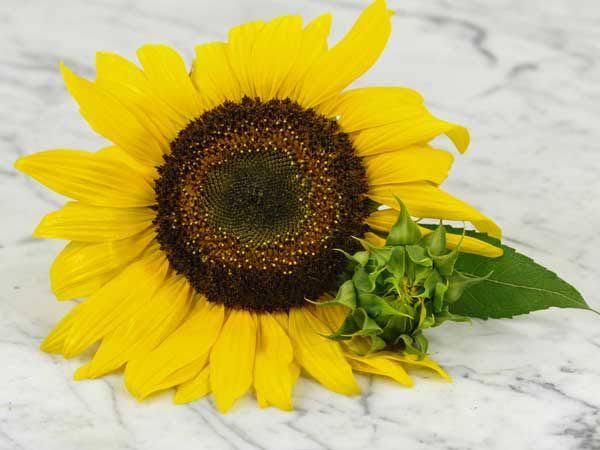
Named after the Native American tribe that grew it as food, medicinal and ceremonial plant, it is easy to grow and sensational at the back of a sunny border. Arikara sunflower is a fast-growing annual with broad, oval to heart-shaped, rough hairy leaves. In summer, it produces large, single and multi headed flowers, up to 12-16 inches across, with brilliant orange or yellow petals surrounding a usually dark chocolate central disk.
Mammoth Grey Stripe
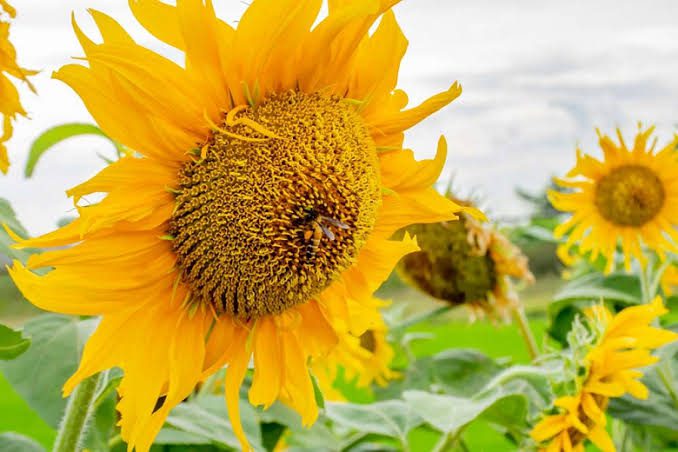
Mammoth Grey Stripe is a giant variety boasting huge flowers, up to 8-12 inch across with brilliant golden-yellow petals surrounding a dark chocolate central disk. This variety produces strong, sturdy stalks that can get as tall as 12′. Plant a row of these to create a wind-break or shaded area around your garden or homestead.
Kong Giant Sunflower
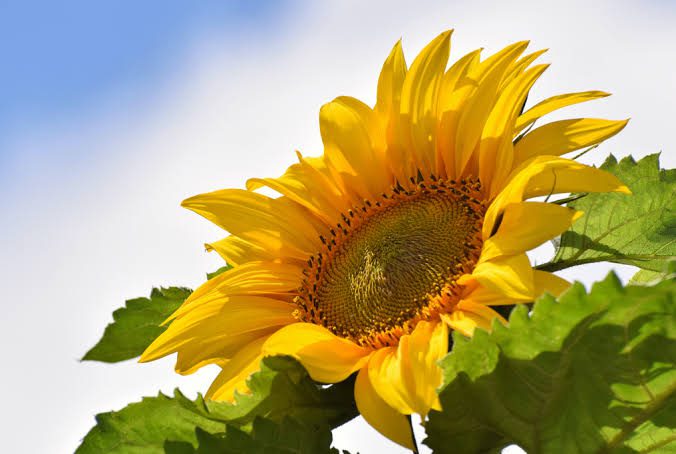
Kong Giant Sunflower is a hybrid sunflower variety that towers above the rest. This giant sunflower variety produces plants that can get as tall as 17′ feet. The thick, strong stalks produce tons of foliage with branches and blooms all along the main stalk. The blooms average 10″ in diameter. This is a fast-growing variety that works great for garden borders or hedge rows. It also works great as a secondary trellis once the plants are done blooming.
Also Read: Types of Fern Plants
Schweinitz’s Sunflower

Schweinitz’s sunflower usually grows to about 6.5 feet and sometimes reaching heights of 16 feet. The sunflower produces tubers and rhizomes underground. Its stems are purple and usually solitary, branching only at or above mid-stem. Its leaves are thick and stiff, tending to droop towards the end. The sunflower is perennial, and flowers for about two to three weeks in early October.
Dwarf Sunflower Varieties
Dwarf sunflowers are great for raised beds or container gardens. Dwarf sunflowers are also great for inter-planting in the vegetable garden as they won’t shade other plants due to their smaller size.
Suntastic Yellow Sunflower
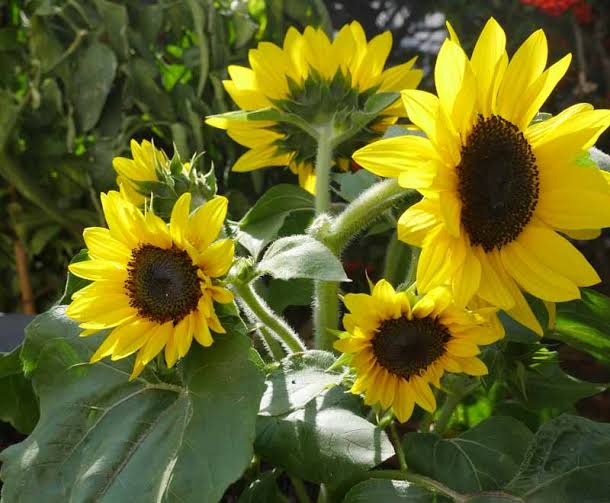
Suntastic Yellow sunflower is a dwarf, well-branched annual boasting a profusion of large blossoms up to 6 inch, adorned with bright golden petals and chocolate brown centers. Blooming in summer over three successive periods, it produces up to 20 flowers per plant and will bloom in less than 65 days. Suntastic yellow is very floriferous and perfect for pots, containers, window boxes or low bedding.
Teddy Bear Sunflower

Teddy Bear Sunflower has unique, double blooms that are soft, velvety and resemble the coat on a teddy bear. Blooms average 6 inch diameter and have a deep yellow color. This is a dwarf sunflower variety that produces plants around 2-3 inch tall. They work great when grown in the ground or in containers. The height of the mature plant will vary depending on the size of the container used for growing.
Teddy Bear Sunflower is a great cut flower variety as it adds beautiful color and texture to any table bouquet. It’s also a great pollinator attractor for vegetables gardens, increasing yields by attracting more beneficial and pollinating insects. Sunflowers work great when planted on the border of the vegetable garden as it provides beauty and brings plenty of bees for pollinating vegetable plants.
Firecracker Sunflower
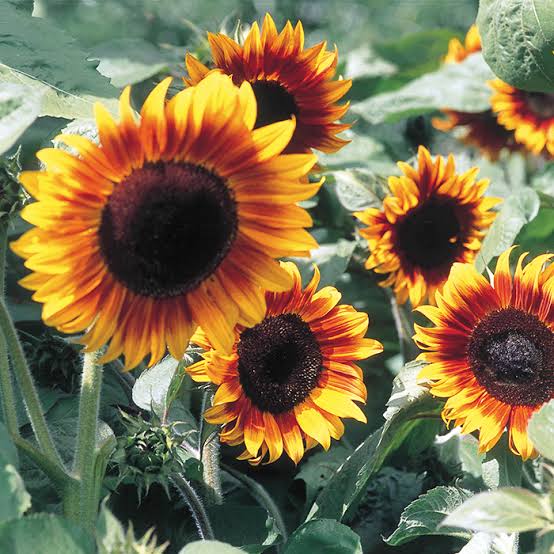
Firecracker Sunflower is a hybrid, pollenless variety that produces beautiful, bi-colored blooms on compact plants. This is a semi-dwarf variety that averages 4-6 inch tall, making it a great option for container or small-scale gardens. It also makes a great border plant in larger plantings.
Firecracker Sunflower is a branching variety that can produce up to 10 blooms at a time. The flowers have a dark disk and bi-colored petals that have a red interior and yellow exterior. Each bloom has a long stem, making it an ideal variety for cut flower production.
Also Read: Types of Palm Trees
Sunspot Dwarf Sunflower
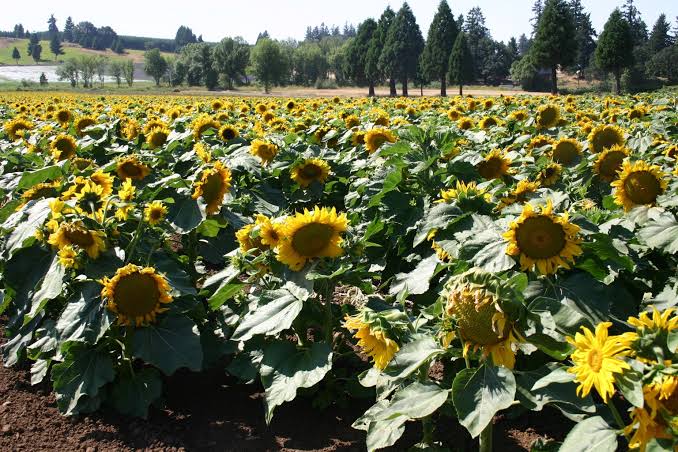
Sunspot Dwarf Sunflower is a shorter sunflower variety that produces enormous blooms relative to the height of the plant. These dwarf sunflower plants average 2-3 feet tall but produce blooms that can easily average 10-12 inch diameter with bright golden and orange petals surrounding chocolate brown centers. Plants are full of green foliage and make a great ground cover when planted densely. This variety is drought-tolerant but prefers full sun for optimal growth.
Sungold Dwarf Sunflower

Sungold Dwarf Sunflower is a shorter sunflower variety that grows to 2-3 feet tall. Plants produce loads of 4 inch double blooms that have yellow petals all the way towards the center of the flower head. Blooms have a soft texture and are similar to the Teddy Bear variety. Dwarf sunflowers are great for raised beds or containers where a shorter plant height may be desired.
Mardi Gras Dwarf Sunflower
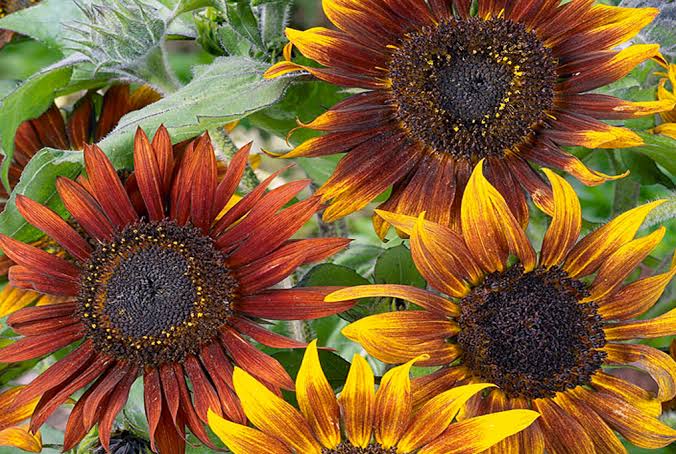
Mardi Gras Dwarf Sunflower contains a vibrant mix of yellow to dark red petal variations that makes an eye-catching addition to any garden. This is a dwarf sunflower variety that reaches 2-3 feet tall. The smaller height is great for raised beds or containers.
Dwarf sunflowers are also great for cut flowers because the heads won’t droop as much when fully bloomed. Mardi Gras Dwarf Sunflower is a multiple-branching variety with blooms that average 5 inch diameter. Petals may be completely dark red or will have a light red to the dark red interior with a yellow exterior.
Santa Fe Sunset Sunflower
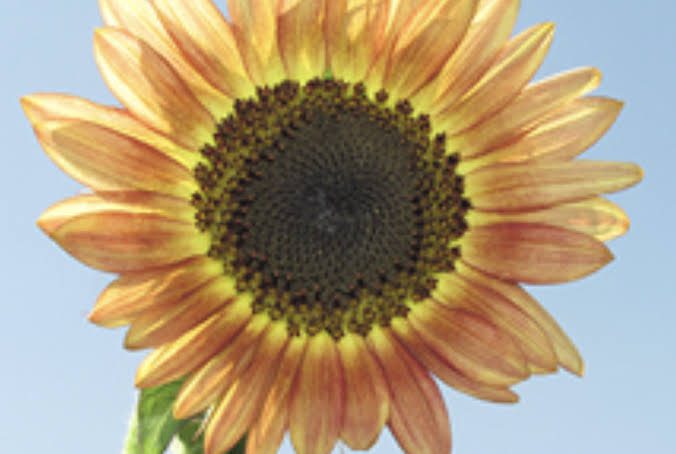
Santa Fe Sunset Sunflower is a hybrid, pollenless sunflower variety with deep burgundy flowers. This variety works great for cut flower production, but will also attract pollinators to the garden for increased vegetable production. Plants reach 5-6 feet tall and produce large blooms with striking color.
Once the main blooms are harvested, plants will continue to produce side shoots and additional blooms. Sunflowers work great when planted on the border of the vegetable garden as it provides beauty and brings plenty of bees for pollinating vegetable plants.
Italian White Sunflower

Sunflowers are stunning annuals or perennials which vary in height, flower size and color. This is a dwarf sunflower variety that produces plants around 2-3 inch tall. Well known as being easy to grow, where there is room for them, they make a bold and impressive display. ‘Italian White’ sports big creamy white flowers with deep chocolate centers.
Also Read: Varieties of Black-eyed Susan
Medium-sized Varieties
Silverleaf Sunflower
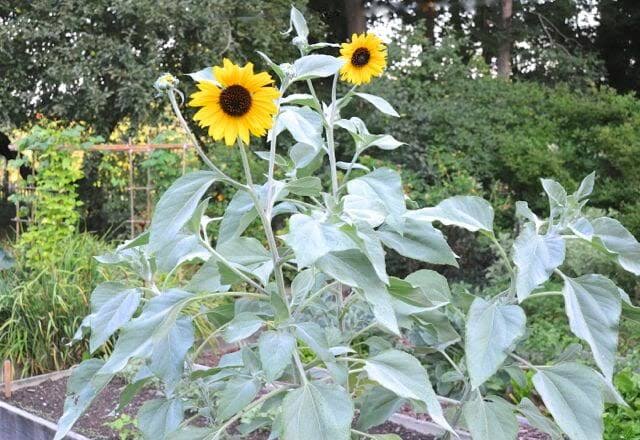
Silverleaf sunflower is a medium size, multi-branching variety of sunflower with a magnificient foliage of silver felted leaves and a profusion of sunny yellow flowers, up to 4 inch wide, each adorned with a chocolate center. One plant can produce up to 1-5 flower heads. Extremely long blooming from mid-summer until frost, the blossoms are particularly attractive to goldfinches as they move to eat the seeds directly from the seedheads.
Woodland Sunflower
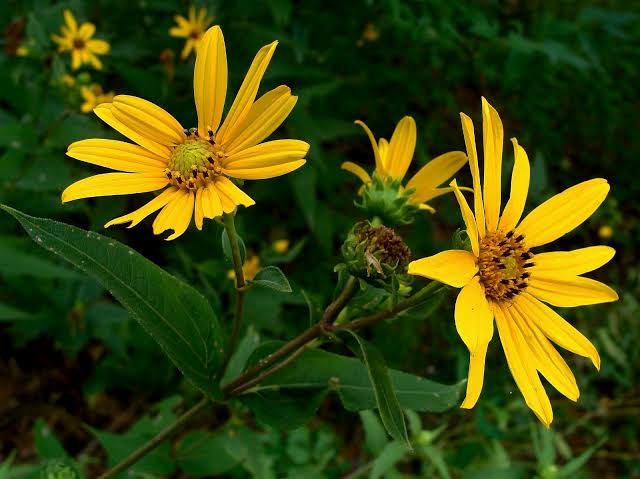
Woodland Sunflower is a showy rhizomatous variety of sunflower with sessile or short-stalked leaves, 6 inches long and a profusion of yellow flowers 2 inch across, each adorned with up to 8-15 yellow rays and a darker yellow center disk. Blooming from early summer to fall, they are borne atop tall, smooth stems and are attractive to bees, butterflies and other pollinators. The woodland sunflower is normally found in most to moderately moist and sandy to loamy sandy areas.
Low-Down (Willow-leaved Sunflower)
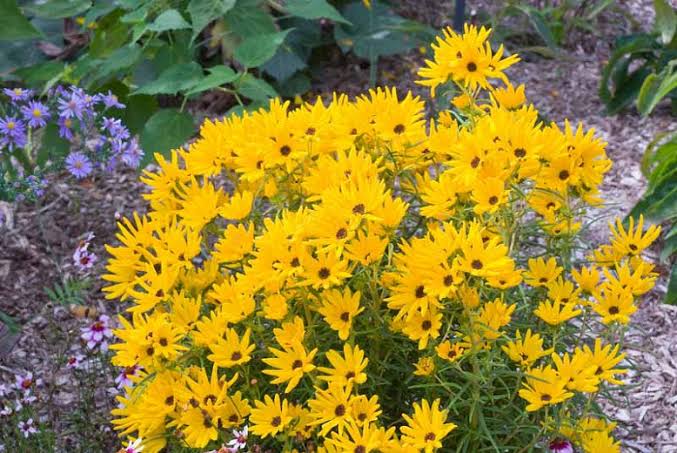
Willow-leaved Sunflower is a vigorous clump-forming perennial boasting upright stems clothed with narrow, arching, willow-like leaves, 5-7 inch long. Blooming from late summer to late fall, showy sprays of brilliant yellow daisies, up to 3 inch across, adorned with a dark chocolate center disk. Willow-leaved sunflower is suitable for a traditional perennial border and is attractive to butterflies and other insect pollinators.
Also Read: Types of Black Flowers
Swamp Sunflower
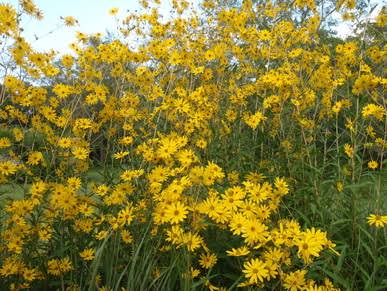
Swamp Sunflower is a showy perennial forming a clump of tall and sturdy, green to purplish pubescent stems. They boast a profusion of brilliant golden-yellow flowers 2-3 inch across from fall to frost. Each flower features 10-20 yellow narrow, pointed rays surrounding a purplish-brown disk. The narrow willowy leaves are hairy and pointed at the tip. Swamp sunflower grows from a branched, colonizing crown that spreads outward at a moderate rate. It is suitable for rain gardens or along streams and ponds.
Western Sunflower

Western sunflower is a showy perennial forming a rosette of large, ovate, medium green, basal leaves. Blooming for an extended period from mid-summer to fall, a profusion of elegant star-like flowers 2 inch wide are born on upright, almost naked, stems. Each flowering stalk terminates in 1-12 flowerheads that are usually arranged in a panicle.
The flowers are particularly attractive to birds as they love to eat the seeds directly from the seedheads. Because of its prominent basal leaves and nearly naked flowering stalks, this perennial wildflower has a very distinct appearance among the Helianthus ssp.
Maximillan Sunflower
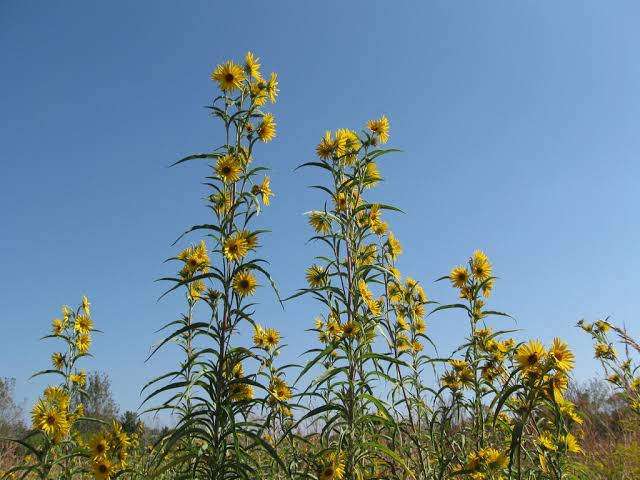
Maximillan sunflower is a branching perennial plant, growing from a stout rhizome and reaches heights from 1.7–3.5 feet. The slender, tall, erect stems and alternately-arranged leaves are covered in rough hairs. The lance-shaped leaves are narrow, pointed, folded down lengthwise, and up to 30 centimeters (12 inches) long on large plants.
The flower heads are surrounded at the base by pointed green phyllaries which often stick straight out and curl at the tips. The center is filled with yellow tipped brown disc florets and the circumference is lined with bright yellow ray florets 2 to 4 centimeters long.
Also Read: Types of White Flowers
Colored Sunflower Varieties
Joker Sunflower
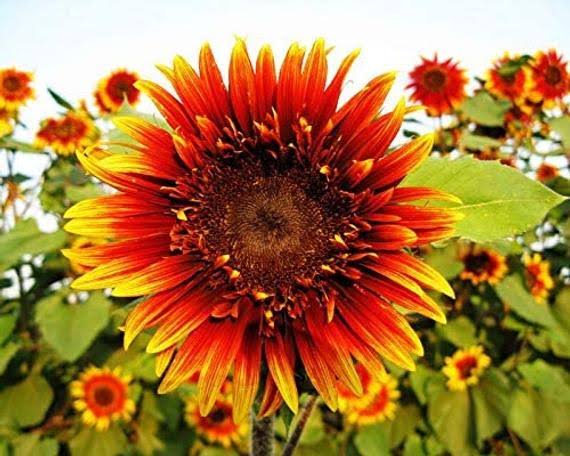
Joker Sunflower is a hybrid, pollenless sunflower variety that is the perfect “wild card” for your garden. This variety has a unique, double starburst pattern on large, 6-8 inch blooms. Joker works great for attracting pollinators to the vegetable garden, but is also ideal for cut-flower bouquets because the blooms are pollen-free.
Plants grow to 6-7 feet tall, which makes this a great option for a border plant around the garden. Joker Sunflower plants are branching and will continue to produce additional blooms throughout the growing season. The large flower heads have a fuzzy, brown disk in the center with a slight yellow fringe surrounding the disk. The petals have a maroon center and are tipped with yellow to provide a fabulous, eye-catching appearance.
Chocolate Cherry Sunflower
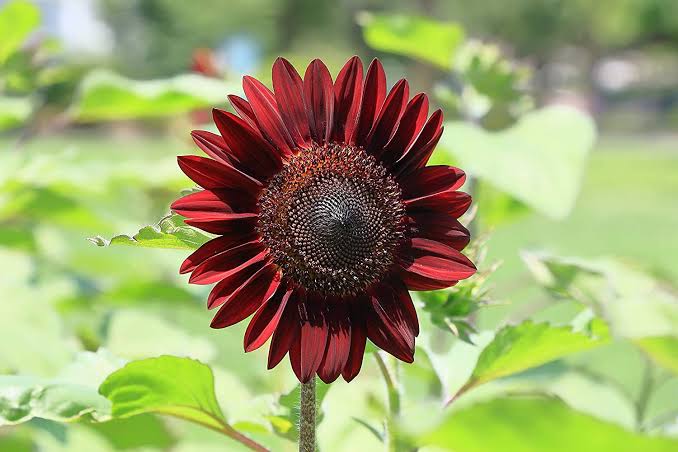
Chocolate Cherry Sunflower is a branching variety with dark burgundy petals and a chocolate-colored disk. This sunflower variety averages a maximum height of 6-7 feet and will bloom continuously for 4 weeks. Chocolate Cherry is a great option for pollinator gardens or cut-flower production.
The stunning, dark blooms will attract pollinators and other beneficial insects to your garden. This variety works great as a border planting around the edges of the vegetable garden to increase pollination and reduce harmful insect pressure.
Floristan Sunflower

Floristan is a well-branched annual boasting a profusion of large, bicolored blossoms adorned with reddish-brown petals tipped in golden-yellow and a chocolate brown center. Blooming throughout the season, this sunflower is perfect for containers or the sunny borders and well suited for cut flower production.
Evening Sun Sunflower

Evening sun is a fast-growing, well-branched annual with oblong to lanceolate leaves and flowers that are reminiscent of a brilliant sunset. From summer to fall, it produces a profusion of large blossoms up to 8-10 inch across, adorned with warm copper to mahogany petals and a dark chocolate central disc. The flower heads are attractive to bees, butterflies and birds.
Also Read: Types of Begonia
Strawberry Blonde Sunflower
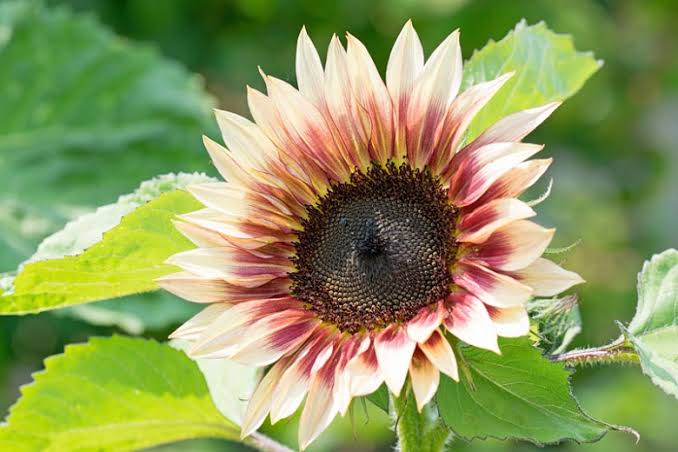
Strawberry Blonde Sunflower is a fast-growing, well branched annual with oblong to lanceolate leaves. It is typically considered as one of mesmerizing varieties of sunflowers, it feature pink and burgundy colors as well as hints of yellow, around the dark disk. The petals fade into yellow shades as they move away from the center. It almost looks like a sunset bursting from every flower. The flower heads are attractive to bees, butterflies and birds.
Ring of Fire Sunflower

Ring of fire is a fast-growing, well branched annual with oblong to lanceolate leaves and particularly beautiful flowers. In summer it produces a profusion of large blossoms, up to 5 inch across with golden petal edges and a ring of mahogany-red surrounding the chocolate brown center.
Gypsy Charmer Sunflower

Gypsy charmer grows between 4 to 6 feet tall. It flowers for weeks and is an enchanting sunflower for the garden and the vase. In summer it produces a profusion of large blossoms up to 6-8 inch cross with multicolored petals, a wonderful mix of brilliant yellow, rosy-red and lemon yellow. The flower heads are attractive to bees, butterflies and birds. It’s great for small mixed bouquets or simply as a colorful accent in your garden.
Claret Sunflower

Claret sunflower is one of the darkest sunflowers growing between 4 and 6 feet tall. Velvety chocolate petals, some streaked with burnished amber, especially on the backs are the hallmarks of this great sunflower. The seeds harvested from grown plants are edible and can be used in snacks and in baking. Other than growing at the back of a sunny border, this sunflower variety makes outstanding cut flower too.
Also Read: Types of Bamboo Plant
Terracotta Sunflower
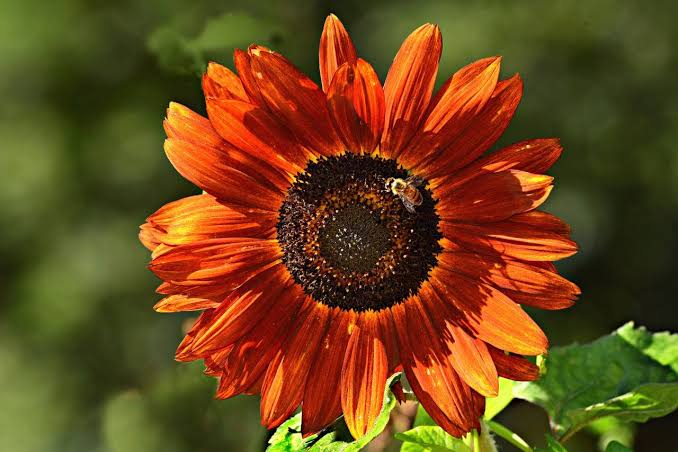
Earthy autumn shades of rusty red, burnt orange, and hints of glowing gold make up the palette for Terracotta sunflowers. Nicely branching, 5-7 ft. tall plants produce many pollen-free, 4-7 inch flowers that open deep red and evolve into warm orange and brown tones as the flowers mature. The undersides of the petals are showy and flame-like. Terracotta sunflower was a winner in our trial gardens for luxuriously rich colors and long-lasting flowers, both on the plant and for cutting.
How to Grow Giant Sunflower Plants
- Giant Sunflowers need to be grown in full sun. Soil conditions can vary, from average a to rich soil. To produce optimum growth, the soil should be very rich. The richer the soil, the better the plant growth. The soil should also be well drained. Dig a hole two to three feet deep. Fill it with layers of compost, regular garden soil, and manure. This will help to promote optimum plant growth.
- One of the important ingredients to fueling giant growth, is a regular supply of fertilizer. Begin your fertilizer regimen with a high nitrogen formula. If you are growing sunflowers for record height, continue the high nitrogen formula all season long. For big blooms, switch to a high phosphorous formula, as the plant nears its expected height and the flowerhead begins to form.
- Give your plants a regular supply of water. Deeply water your plants, to assure it gets to all of the roots. Do not allow the soil to dry out. And, do not soak the soil.
- Staking giant sunflower plants is very important. These tall, heavy plants are susceptible to falling over on windy days. The stake doesn’t have to be as tall as the plant. But, it should be several feet tall, and anchored firmly into the ground.
- Harvest sunflower seeds after the bloom have died. Check a seed or two. Squeeze it to see if it is hard and full. If hollow or soft, it is not ready. The trick is to get them when they are mature, and before the birds get to the seeds.
Importance of Sunflower In The Garden
- The taller varieties provide shade for vegetables that appreciate some afternoon shade like tomatoes, peppers, and eggplant. We transplant the vegetables after the sunflowers are about 1 – 2 feet tall to avoid the seed germination inhibition.
- The large, composite flowers are magnets for bees of all kinds, especially bumblebees, as well as attracting a myriad of pollinators into the garden, from different bees to butterflies and even hummingbirds.
- Sunflowers have one of the most aggressive root systems known, drilling down through hardpan or clay. We’ve used them as the first stage in cover cropping a new area, opening up the soil making it easier for the next cover crop mixture. They also work great to pulverize a hard spot in the raised beds or flower bed, making it perfect for next season.
- Sunflowers make an excellent windbreak in our southwestern climate, we plant them on the south and west sides of the garden to slow down and filter the near-constant winds to something our tomatoes, peppers, and corn can handle.
- Once the seeds mature, they bring in tiny finches and myriad other birds who delight in pulling the seeds out of the head and feeding on them one by one.
- Their roots have one of the most aggressive allelopathic effects on seed germination we’ve seen. The allelopathic effect inhibits other seeds from germinating in the same soil, and is one of the reasons when weeds pop up first – everything else has a hard time growing. Sunflowers are used to put the hurt on weed seeds.
Conclusion
Sunflowers are one of those species that really do tick every box. Aesthetically, they are as showy and dazzling as they come. Practically, they are incredibly easy to grow, with really good resistance to drought and pests. Economically, you can grow dozens of them from seed for less than the price of a pint and, if you save the ones you grow, you can produce hundreds more the next year. Yet perhaps the reason they aren’t as popular as they deserve to be is that few people are aware of their enormous diversity, which goes far beyond the giant, dwarf and colored types that immediately come to mind.
Further References
- Sunflower Facts: https://plantvillage.psu.edu/topics/sunflower/infos
- Sunflower: https://www.britannica.com/plant/sunflower-plant
- Sunflower Types: https://www.ftd.com/blog/share/types-of-sunflowers
- Sunflower Varieties: https://www.homestratosphere.com/types-of-sunflowers/
- Sunflower Information: https://en.m.wikipedia.org/wiki/Helianthus